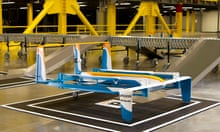Amazon has announced that it will partner with the British government to run tests exploring the viability of delivery of small parcels by drone – the first time such tests have been run in the UK.
The company announced that a cross-government team supported by the Civil Aviation Authority (CAA) gave permission to Amazon to explore three key areas: operations beyond line of sight, obstacle avoidance and flights where one person operates multiple autonomous drones.
The experiment will look at drones carrying deliveries weighing 2.3kg (5lb) or less – which make up 90% of Amazon’s sales, a company spokeswoman said.
A representative for the CAA said that a priority during the tests would be making sure that drone delivery did not adversely affect other airspace users.
During the test the drones will be limited to an altitude of 400ft (122m) – as is standard among private drone operations – and kept away from operating near airport flightpaths.An Amazon spokeswoman said that making sure the system can operate safely is the top priority of the tests. “We’re not going to launch until we can demonstrate safety, and that’s what this programme is going to do,” she continued.
“We want to enable the innovation that arises from the development of drone technology by safely integrating drones into the overall aviation system,” Tim Johnson, CAA policy director, said. “These tests by Amazon will help inform our policy and future approach.”
Beyond special testing scenarios such as that granted to Amazon, current UK legislation dictates that drones cannot be flown within 50 metres of a building or a person, or within 150 metres of a built-up area. Drones also have to remain in line of sight and within 500 metres of the pilot, which has hampered attempts to use drones for delivery or surveillance purposes before.
Pilots must also complete a training course and apply for a permit from the CAA to fly the drone for commercial purposes.
Amazon is also testing its drones in the US but faces significant restrictions. The US Federal Aviation Administration (FAA) will only allow commercial drones to fly where the drone and its payload weigh less than 55lb, it stays within unaided sight of the pilot and each drone has its own pilot. Commercial drones can also only fly during daylight, from 30 minutes before sunrise until 30 minutes after sunset. The same rules do not apply to recreational drone flights.
The online retailer is not the only company developing and testing drones for delivery in the US. Google recently showed off a fixed-wing drone system capable of carrying packages.
But arguably the most promising tests have come from drone manufacturer Flirtey. It partnered with the FAA and Nasa for the first successful US drone delivery in July 2015 and again from ship-to-shore in New Jersey in June 2016, as a potential disaster-relief delivery method.
Meanwhile, similar technology is being tested as a potential method of human transport. The world’s first passenger drone, the Chinese Ehang 184, was recently cleared for testing in Nevada, partnering with the state’s Institute for Autonomous Systems and the governor’s office of economic development. The Ehang 184 promises to transport a person at altitudes up to 11,500ft and speeds of up to 100km/h for up to 23 minutes, powered by eight propellers on four arms.
With outstanding technical and regulatory issues yet to be resolved, commercial delivery drones are not expected to become commonplace in our skies any time soon.










Comments (…)
Sign in or create your Guardian account to join the discussion